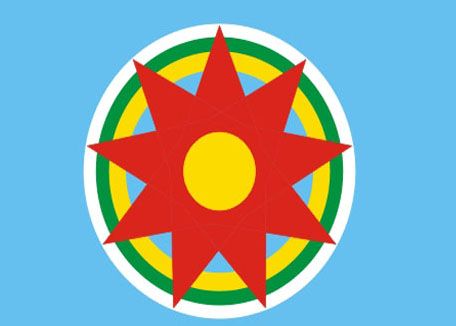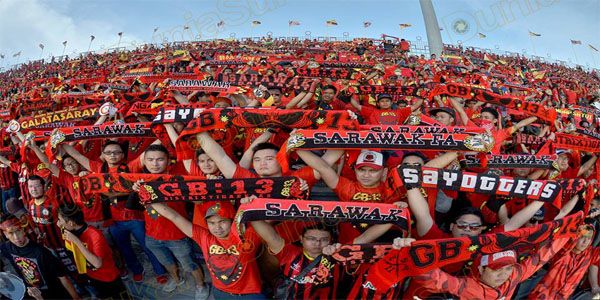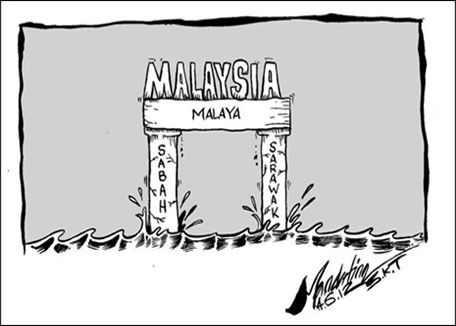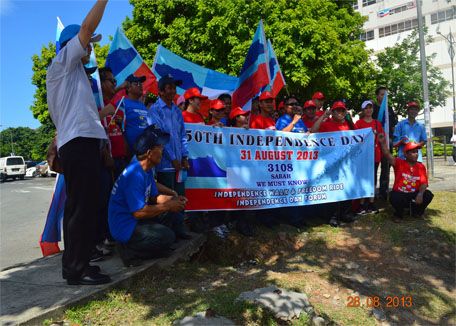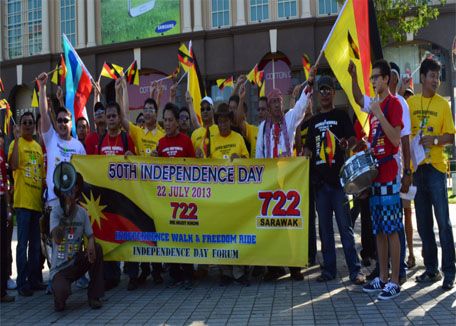1835
Beginning of the Sarawak Rebellion (against the Sultan of Brunei) led by Sarawak chief Datu Patinggi Ali.
1839
James Brooke arrives in Kuching on the Royalist carrying a message of thanks and presents from the Governor of Singapore to Rajah Muda Hassim in Sarawak. He returns later and at the request of the Rajah Muda Hassim, the Sultan of Brunei, suppresses the rebellion.
Sept 21 1841
Brooke made rajah and governor of Sarawak after Rajah Muda Hassim dismisses Makota.
1845
The battle of Marudu Bay sees Brooke enlisting the help of the British Royal Navy in Singapore to defeat Sherif Osman, a famous pirate leader from North Borneo, effectively ending his piracy.
1846
Sultan of Brunei unhappy with the English and Brooke.
His first move against Brooke is to order the killing of Englishmen and everybody in Brunei close to him, which includes Rajah Muda Hassim, his brother Badruddin and other leaders in Brunei.
Brooke attacks Brunei in retaliation. Assisted by the British navy, they capture the city.
The Sultan is allowed to return to his palace after surrendering.
In addition he gives Sarawak completely to Brooke and his heirs forever without payment of any more money.
In memory of Rajah Muda Hassim and Badruddin, he gives two streets in Kuching their names: Jalan Muda Hassim and Badruddin Road. Later, two of his nephews, James and Charles Johnson come to Sarawak to help him.
James is given the title Tuan Besar and later, Rajah Muda.
Charles Johnson is called the Tuan Muda and changes his name to Charles Brooke later when he becomes the second rajah of Sarawak.
1849
The Battle of Beting Maru sees Brooke is defeating Iban pirate chief named Linggir.
He is helped by Captain Farquhar, his ships of the Royal Navy and by Malay and Dayak in prahus.
Altogether there are about 75 boats and 3,500 men on Brooke’s side.
After a hard fight for several hours in the darkness, many pirate ships are sunk and hundreds of pirates killed or captured.
Brooke builds forts at Lingga and the mouth of the Skrang River on Batang Lupar to prevent more attacks.
1850
The US recognizes Sarawak.
1852
Sarawak’s territory expands.
1853
Sarawak extended to the Krian River.
1855
Brooke starts the Supreme Council made up of a small group of important officers in Sarawak to help him govern the country.
1857
Kuching sacked by Chinese rebels.
Six hundred Chinese miners from Bau sail down the Sarawak river at night to attack the Astana, the government buildings and the fort. Much of Kuching is razed to the ground except for the Chinese areas.
Brooke retaliates by enlisting the help of loyal Malays.
Charles sails quickly from Lingga with Iban soldiers.
The rebels retreat up the river and are chased to Bau and to the Dutch Borneo border where they try to escape to Sambas and Pontianak.
As many as 1,000 Chinese rebels and their families are killed.
1861
After their defeat at sea, pirates move farther inland to continue attacking villages and capturing heads.
The chief leader is an Iban named Libau, better known as Rentap.
From his Bukit Sadok fort, he leads his men to attack villages or the Rajah’s forts along the Batang Lupar.
After two unsuccessful counter-attacks, Charles becomes more determined to capture Rentap’s fort at Bukit Sadok.
He builds a twelve-pounder cannon in Kuching which takes 500 of his men to pull through the jungle to Bukit Sadok. Once there, 60 of his strongest men lift the cannon on poles and carry it to the top of Bukit Sadok 3,000 feet high.
The cannon fi re penetrates Rentap’s sturdy fort made of thick belian wood.
They discover, however, that the pirate leader has run off into the jungle and burn his fort.
Rentap is never to be heard of again.
1861
Sarawak is extended to Kidurong Point.
An offer by King Leopold I. of Belgium to purchase Sarawak is not successful.
1862
The Sarawak regiment is created.
1863
Sarawak Dollar introduced.
1864
Britain recognizes Sarawak as an independent principality.
1865
Charles forms the Council Negri which includes people in the Supreme Council, other officers of the rajah’s government and the most important native chiefs.
1867
Council Negri holds its first meeting in Sibu.
1868
James Brooke is succeeded by his nephew Charles.
Brooke returns to England due to ill health and dies there.
1869
Sarawak begins issuing postage stamps.
1870
Sarawak Gazette begins publication.
1872
The name of the town of ‘Sarawak’ is changed to Kuching where it reportedly gets its name from a small brook which ran into the Sarawak River near the present Chinese Chamber of Commerce Building at the end of Main Bazaar.
1883
Sarawak extended to Baram River.
1884
Great fi re of Kuching. 1885 Acquisition of the Limbang area, from Brunei.
1888
Sarawak declared a British protectorate.
1890
Limbang added to Sarawak.
1891
Opening of the Sarawak Museum.
The border between Sarawak and Dutch Borneo is decided at a meeting between Great Britain and the Netherlands (Holland) whereupon it is decided that the border would follow as closely as possible the line of the highest mountains between Sarawak and Dutch Borneo.
1901
Sarawak’s population is 320,000 1903. Oil discovered in Sarawak.
1905
Acquisition of the Lawas Region, from Brunei.
Sarawak spans 47,000 square miles.
1912
Brooke Dry Dock opened. 1915 First railway line in Sarawak opened.
1915
Committee of Administration, seated in Kuching, established.
A 10-mile railway going south from Kuching first used.
1917
Charles Vyner Brooke succeeds his father Charles as Rajah.
1924
Sarawak Penal Code introduced.
1925
Chartered Bank of India, Australia and China builds its first offi ce in Kuching to take care of the payment for Sarawak;s increasing business with other countries. 1931 Penghulu Asun leads a small rebellion among the Ibans against the government in the headwaters of the Kanowit, Entabai and Julau Rivers.
Vyner Brooke sends a police expedition up the Kanowit River and captures Asun and most of the other leaders.
Fort Brooke is built at Nanga Meluan on the Kanowit River.
Asun dies of old age in 1958. 1938 Kuching airport opened.
1941
Written constitution granted.
1941
Sarawak has a population of 490,000.
Dec 161941
Japanese occupy Miri.
Dec 19 1941
Japanese bomb Kuching.
Dec 24 1941
Japanese attack and capture Kuching.
1942-1945
Japanese occupation.
August 14 1945
Japanese surrender.
Sept 11 1945
Australian forces liberate Sarawak.
1945-1946
Sarawak is put under Australia’s military administration.
May 1946
Council Negri meets to talk about cession to British government.
They agree that Sarawak should become a colony by a vote of 19 to 16.
July 1 1946
Government passes a law that accepts Sarawak as a British Crown Colony.
1946
Sarawak becomes a British crown colony.
1949
Governor Duncan Stewart is assassinated.
1957
Sarawak gets a new constitution which changes the size and powers of the Council Negri.
Council Negri has increased to 45 members.
1959
First general election held in Sarawak.
1961 May 27
Tunku Abdul Rahman, Prime Minister of Persekutuan Tanah Melayu, at a Foreign Correspondents’ Association of Southeast Asia press conference in Singapore, says the Federation of Malaya should have a close understanding with Britain and the people of Sarawak, Brunei and Sabah.
June 20
Sir Harold Macmillan, British Prime Minister, in a reply to a question in Parliament, says he is interested in the suggestion made by Tunku.
June 26
British officers from Singapore, Sarawak, Brunei and Sabah, consisting of governors, hold a meeting in Singapore until June 27.
July 1
Tunku Abdul Rahman accompanies the Yang Di - Pertuan Agong of Malaya to officially visit Brunei and Sarawak.
July 9
Azahari (Partai Rakyat Brunei), Ong Kee Hui (Sarawak United People’s Party) and Donald Stephens (Sabah) establish the United Front and disagrees with the proposal by Tunku Abdul Rahman and Britain.
July 12
Tunku Abdul Rahman exposes communist threats in South East Asia as an important factor in his proposal.
July 22
Lee Kuan Yew, Singapore chief minister, proposes that representatives from Sarawak, Brunei and Sabah present their views at the Commonwealth Parliamentary Association (CPA) on the Malaysia proposal.
July 28
Establishment of the Malaysia Solidarity Consultative Committee (MSCC) in Singapore during the CPA Conference.
August 12
First visit of leaders from Sarawak and Sabah – Datu Bandar Abang Mustapa, Temenggong Jugah, Donald Stephens and Dato Mustapha – to Malaya to see the progress for themselves.
Many such visits are organized for leaders in Sarawak and Sabah up till the formation of Malaysia.
August 24
MSCC holds its fi rst meeting in Jesselton (now Kota Kinabalu) in North Borneo (Sabah).
Brunei did not attend.
October 16
A motion for the formation of Malaysia is tabled in Parliament by Tunku Abdul Rahman and is approved.
November 23
Malaya negotiates with Britain to amend the Defence Agreement to expand British assistance when Malaysia is formed and to maintain their army camps.
Malaya and Britain negotiate and agree on the setting up of an investigative commission on the formation of Malaysia.
December
Parti Barisan Anak Jati Sarawak (Barjasa) is registered.
Political parties formed earlier are the Sarawak United People’s Party (SUPP) on 12 June 1959, Parti Negara Sarawak (Panas) on 9 April 1960 and Sarawak National Party (SNAP) on 10 April 1961.
These older parties are formed for local council and district elections that started in 1959.
December 18
MSCC holds its second meeting in Kuching.
Brunei attends only as observer.
December 20
The stand of Sarawak and Sabah shifts from opposition to bargaining on issues such as representation in parliament, freedom of religion, national language, civil service, immigration and economic development as stated in a press statement at the end of the MSCC meeting.
December 30
During a conference in Jakarta, Partai Komunis Indonesia (PKI), the third largest communist party in the world, condemns the formation of Malaysia as a British neo-colonist ploy.
1962 January 4
British colonial government in Sarawak publishes a white paper on Sarawak’s consent for Malaysia and the establishment of an investigative commission proposed by the governments of Malaya and Britain on November 23, 1961.
The White Paper is translated into local dialects and widely distributed in Sarawak.
January 8
MSCC holds its third meeting on constitution and politics in Kuala Lumpur.
A decision is reached to produce all the proceedings for public consumption just as the British colonial government had done in Sarawak. January 31 British colonial government in Sabah produces a white paper, similar to the one published in Sarawak.
It is also translated into local languages and distributed widely.
February 1
MSCC holds its fourth and last meeting in Singapore.
February 3
All MSCC delegates sign a memorandum of proposals and recommendations which is then published in Sarawak and Sabah.
The Cobbold Commission is set up to seek the views of the people of Sarawak and Sabah on the formation of Malaysia.
Members of the commission are Lord Cobbold (chairman), Sir Anthony Abell and Sir David Watheraton (British representatives) Dato Wong Pow and Ghazali Shafie (representatives of Malaya).
February 19
The Cobbold Commission arrives in Kuching to begin public hearings at 35 centres.
March 6
Deputy Prime Minister of Malaya, Tun Abdul Razak, said that at that time only Britain and the Philippines were involved in the territorial claims over Sabah.
April 17
The Cobbold Commission completes its task in Sarawak and fl ies to Jesselton to continue its investigations at 15 centres in Sabah.
April 24
The legislative assembly of the Philippines unanimously approve “Resolution No.7… the President of the Republic to take the necessary steps consistent with international law and procedure for the recovery of a certain portion of the Island of Borneo and adjacent islands which appertain to the Philippines”.
April 29
Sultan of Sulu hands over the rule of Sulu (which has never been colonised by Spain or the United States of America) to the Philippines until she was accepted as an independent sovereign country.
May 24
The British government sends a memorandum to the ruler of the Philippines on its claim to a part of Sabah.
The other part was previously under the Brunei sultanate, particularly along the west coast.
June 22
The ruler of the Philippines sends a note to the British government on its claim over Sabah.
June 24
Donald Stephen, President United Kadazan Organisation (UNKO), says the people of Sabah challenge the claim by the Philippines.
June 27
Sarawak Chinese Association (SCA) Party formed.
July
The Cobbold Commission sends its report to the government of Malaya and Britain .
July 18
Sultan Omar Ali Saifudin, Sultan Brunei, declares that Brunei will join Malaysia separately from Sarawak and Sabah.
July 20
Parti Pesaka formed.
The ruler of the Philippines sends a note on its Sabah claim to the government of Malaya.
August 1
Negotiations on the Cobbold Report between Malaya led by Tunku Abdul Rahman and his colleague from Britain to announce the formation of the Federation of Malaysia on August 31, 1963 after it is approved by their respective legislatures.
August 30
Inter – Government Committee (IGC) holds a preparatory meeting in Jesselton, Sabah, and sets up its headquarters there.
Sabah political parties submit the Twenty Points claim to Deputy Prime Minister of the Federation of Malaya.
Tun Abdul Razak and Lord Landsowne in Jesselton.
September 12
The Sabah State Legislative Assembly unanimously approves the formation of the Federation of Malaysia and the establishment of the IGC.
September 26
The Sarawak State Legislative Assembly unanimously approves the formation of the Federation of Malaysia and the establishment of the IGC.
The Sabah Alliance is set up by Pasok Momogun, Sabah United Party, United Kadazan Organization (UNKO) and United Sabah National Organization (USNO).
September
Philippines Vice President, Emmanuel Paleaez, declares his country’s claims to a part of Sabah at the United Nations, New York. October 16 Sabah Alliance declares the opposition of the people of Sabah on the claim of the Philippines.
December
Sabah Alliance wins the election with 131 out of 137 contested constituencies with a manifesto based on the Twenty Points.
December 8
Partai Rakyat Brunei causes a revolt in Brunei, Limbang, Lawas and Miri.
December 9
A M Azahari, Partai Rakyat Brunei chairman, announces the North Kalimantan Revolution Government while in exile in Manila. He is actually a citizen of Lebanon; his father had married the daughter of Hugh Low, the British Governor of Labuan, who had married a Sarawakian woman, Dayang Loyang.
December 20
IGC holds its last meeting in Kuala Lumpur.
It had held 24 meetings in Kuching, Jeselton, Singapore and Kuala Lumpur.
1963 January 5
Curfew from 6pm to 6am is enforced in Limbang. January 8 The Governor declares as illegal the Sarawak Farmers’ Association, Kesatuan Rakyat Insaf Sarawak, Chung Hua Alumni Association Sibu, Tentera Nasional Kalimantan Utara, Angkatan Dosu Berantu and Angkatan Rakyat Anak Sabah.
January 28
British Foreign Secretary Lord Home and Philippines Vice President Emmanuel Palaez begins negotiations on claims over Sabah until February 1 with no results.
Diosado Macapagal, the President of the Philippines states for the first time his country’s opposition to the formation of Malaysia in his state-of-the nation speech in the Philippines Congress.
February 11
Dr Subandario, Indonesia Foreign Minister, officially objects to the formation of Malaysia.
February 23
IGC submits Reports to the Governments of the Four Parties Concerned – Britain, Malaya, Sarawak and Sabah.
The IGC report is published.
March 8
Sarawak State Legislative Assembly unanimously adopts the recommendations in the IGC report.
March 13
Sabah State Legislative Assembly adopts recommendations in the IGC report.
April
Sarawak local council elections are held until June.
May 15
Third Rajah Sir Charles Vyner Brooke passes away in England.
May 31
Tunku Abdul Rahman, Prime Minister of Malaya and Sukarno, President of the Republic of Indonesia negotiate in Tokyo for an agreement o n the formation of Malaysia and to stop Indonesia from sending her army into Sarawak and Sabah.
June18
The Sarawak Flag will use the old fl ag with a crown in the centre.
June19
The results of the election are announced – Alliance 78, Independent 67, SUPP 16 and Panas 11.
June 20
31 Independent legislators join Alliance, bringing the tally to 119.
July 9
The Malaysia Agreement is reached by Britain, Malaya, Singapore, Sarawak and Sabah.
Brunei withdraws at the last moment.
It is signed by Temenggong Jugah, Dato Bandar Abang Mustapa, Abang Openg, Ling Beng Siew and PEH Pike.
From Sabah are Donald Stephens, Dato Mustapha, Khoo Siak Chiew, G S Sundang, WS Holley, and WKH Jones.
From Singapore are Lee Kuan Yew, and the representatives of Malaya and Britain are Tunku Abdul Rahman and Harold Macmillan respectively.
July 19
British House of Commons approves the Malaysia Bill to enable Sarawak and Sabah to form Malaysia.
July 22
Stephen Kalong Ningkan chosen as the first Chief Minister of Sarawak along with the state’s first cabinet.
July 30
Tunku Abdul Rahman, Sukarno and Macapagal meet at the Manila Summit.
August 5
Manila Summit ends resulting in Manila Declaration in which the three countries agree to form a new confederation called Maphilindo (short for Malaysia, Philippines and Indonesia).
There is also a Manila Accord in which the three countries agree to work together in politics, economics, socially and culturally.
Philippines and Indonesia request that the Secretary General of the United Nations get the views of the people of Sarawak and Sabah on the formation of Malaysia.
August 3
Governor Sir Alexander Waddel launches the 1962 uprising memorial for British commandos who were defeated in Limbang.
August 6
Teo Kui Seng, Natural Resources Minister, also the chairman of the Malaysia Day celebration, announces the programme.
August 8
Sabah Legislative Assembly unanimously passes the Merdeka motion to join Malaysia and also approves the Malaysia Agreement.
August 15
Parliament of the Federation of Malaysia approves the Malaysia Agreement.
August 16
United Nation Malaysia Mission (UNMM) arrives and carries out its task to get the opinion of the people of Sarawak and Sabah until September 5, 1963.
Their arrival is also met with anti-Malaysia protestors at the Kuching Airport.
August18
Indonesian soldiers and insurgents invade Sungai Bangkit in Song, resulting in a casualty.
August 19
Abdul Taib Mahmud, Communication and Works Minister, visits the headquarters of the Public Works Department in Kuching.
The merdeka celebration is postponed from August 31 to September 16.
August 26
Yang Di-Pertuan Agong of Malaya approves the Malaysian constitution.
August 27
Demonstrations against Malaysia in Sibu in connection with the arrival of the UNMM team.
August 29
Yang Di-Pertuan Agong signs the Malaysia Declaration, fi xed on September 16, 1963.
Anti-Malaysia protest in Miri on the arrival of the UNMM team results in a clash with the police. August 30 UNMM team arrives in Limbang, its last stop.
September 1
UNMM representative, Lawrence Michelmore, meets representatives from Alliance and SUPP at the State Legislative Assembly chambers.
September 4
Sarawak Legislative Assembly approves Malaysia motion with 38 votes for and five against.
Stephen Kalong Ningkan tables the motion which states: “Be it resolved that this Council reaffirms its support for Malaysia, endorses the formal agreement which was signed in London on the 9th July and, while regretting that the Federation of Malaysia could not be brought into being on the 31st August, welcomes the decision to establish it on the 16th September, 1963.” September 5 UNMM team leaves Sarawak.
September 11
Chief Minister, Stephen Kalong Ningkan, and three ministers as well as 10 members of the Alliance fly to Kuala Lumpur to meet the Prime Minister and the Secretary of the Colony of Britain, Duncan Sandys.
September 13
UNMM presents its report.
“The Mission is satisfi ed that through its hearings it was able to reach a crosssection of the population in all walks of life and that the expressions of opinion that it heard represent the views of a sizeable majority of the population.
The Mission is convinced that the time devoted to hearings and the number of localities visited was adequate and enabled it to fully carry out its terms of references.”
Sir Alexander Waddell announces that Datu Abang Openg is appointed by the Yang Di-Pertuan as the first Yang Di-Pertua of Sarawak beginning from Malaysia Day.
Temenggong Jugah Barieng is appointed to the Federal Cabinet as the Sarawak Affairs Minister.
September 14
Duncan Sandys arrives in Kuching for a brief visit. September 15 Dr M Sockalingam is appointed as the Speaker of the Sarawak Dewan Undangan Negeri.
British colonial Governor, Sir Alexander Waddell, and wife leave Astana, the official Brooke residence and that of British governor since 1870, at exactly 12.30pm.
September 16
Tun Abang Openg is sworn in as the fi rst Yang Di- Pertua Negeri Sarawak. Prime Minister of Malaysia Tunku Abdul Rahman reads the Proclamation of Malaysia in front of the Yang Di-Pertuan Agong, Raja- Raja Melayu and thousands of citizens at Stadium Merdeka to mark the birth of a new country named, the Federation of Malaysia.
He says: “The great day we have long awaited has come at last – the birth of Malaysia.
In a warm spirit of joy and hope ten million people of many races in all the states of Malaya, Singapore, Sarawak and Sabah now join hands in freedom and joy.”
Khir Johari reads Proclamation of Malaysia as the representative of the Prime Minister to mark the independence of Sarawak in the presence of Tuan Yang Terutama Tun Abang Openg, Chief Minister Datuk Stephen Kalong Ningkan, the State Cabinet and the people at Padang Sentral (now Padang Merdeka), Kuching, and in all divisions of Sarawak.
(Chronology is translated from the official 45th anniversary souvenir book, ‘Perayaan 45 Tahun Sarawak Maju Dalam Malaysia, 1963 – 2008).
Read more: http://www.theborneopost.com/2011/09/16/chronology-of-sarawak-throughout-the-brooke-era-to-malaysia-day/#ixzz2jk1UJdFP

